Right and wrong.
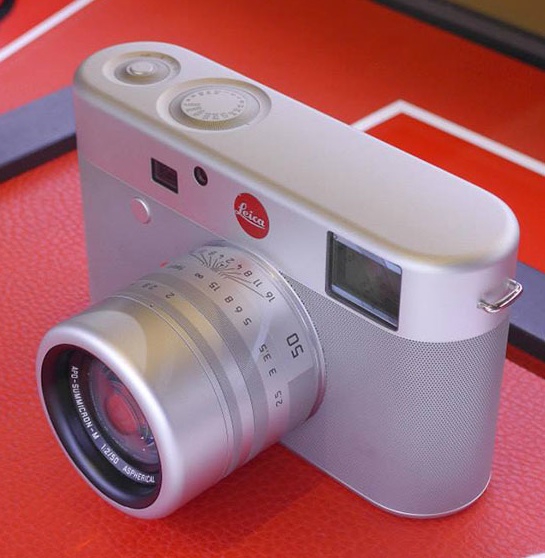
Leica M Red, by Jony Ive.
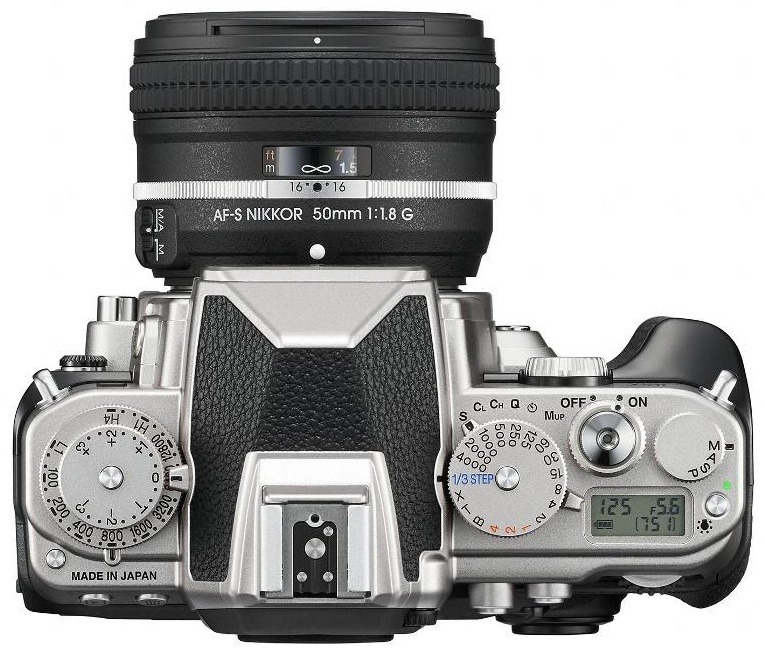
Nikon Df.
Maybe the people at Nikon should spend some time with Mr. Ive?
Right and wrong.


Maybe the people at Nikon should spend some time with Mr. Ive?
Wi-fi.
Part IV is here.
There are excellent descriptions of how to enable Wi-fi in the GX7 at CameraLabs.
I’ll add some personal experiences below.
Wi-fi:
Wi-fi on the GX7 means that you can send images to your portable device of choice – cell phone or tablet, iOS or Android – after first having downloaded the Panasonic Image App from the AppStore (iOS) or GameStore (Android). The app is free. Further, once the GX7 is connected to the device, you can control just about anything on the camera – focus (using the touch screen on the cell phone or tablet), framing rate, movie mode, you name it. However, you cannot send or receive emails while the camera and device are connected as they share a wi-fi circuit unique to the two devices. So if you download images from the camera to your device, you must then switch to your regular wi-fi or cellular connection before these can be sent out.
Here’s the order of events to get wi-fi working:
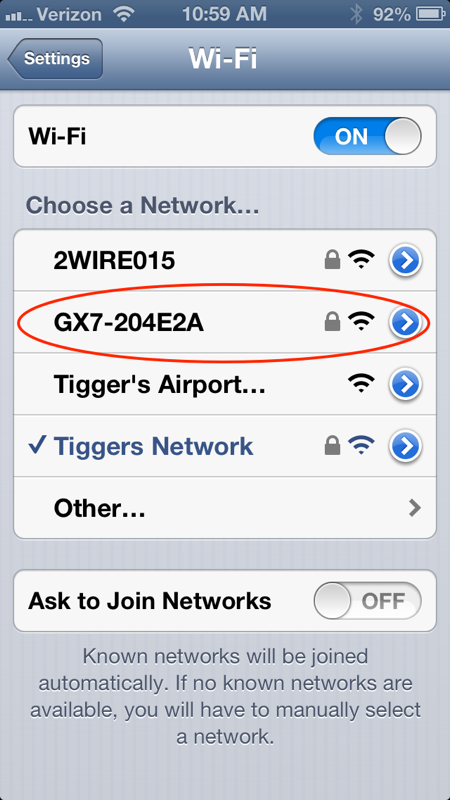
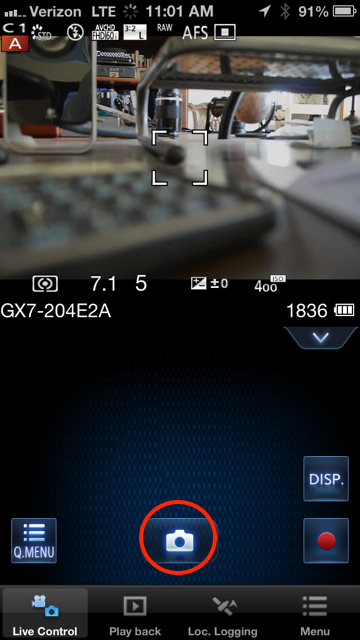
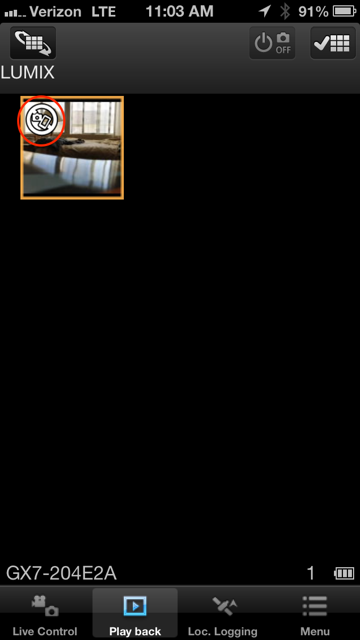
I have successfully tried the above with two iOS devices (iPhone5 and iPad Air) and one Android one (Nexus7 tablet).
While steup is a bit clunky, operation is simple and effective. It’s a nice feature to have if you want to email images on the run or control the GX7 remotely.
A continuing delight.
I have had cause to highlight the Swiss watch maker’s advertising here before and their latest continues one of the classic photography campaigns.
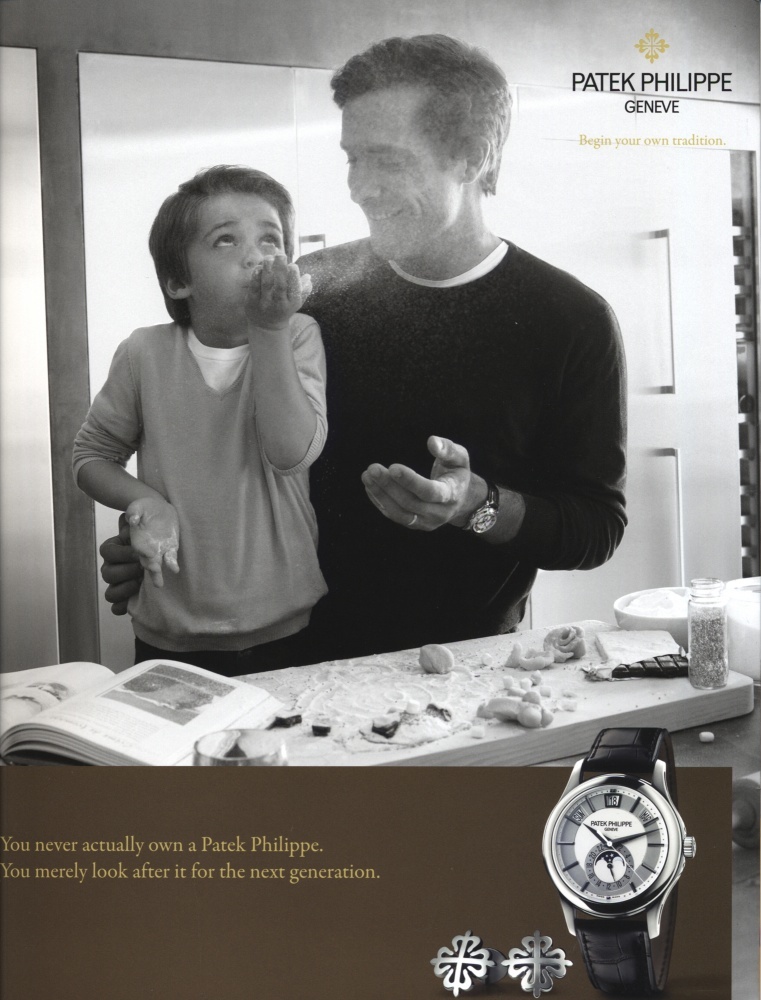
I only hope that when my boy comes of age he will appreciate this mechanical throwback with its so-so accuracy and questionable reliability, for heritage is not something which comes in a digital form, confusing as it does precision with accuracy, competence with class.
Manual focus lenses.
Part III is here.
The range of dedicated prime and zoom lenses from Panasonic, Olympus, Sigma and Leica for the MFT format is now very large indeed. Over 40 lenses and counting. But that does not mean that older manual focus lenses from other makers are useless.
The Panasonic GX7 is exceptionally well attuned to the use of these older MF lenses. Mine are Nikkors but adapters are inexpensively available for just about any lens on the planet, owing to the low bayonet flange-to-sensor dimension of the slim body. That means that infinity focus will be attainable on just about every lens ever made. This means owners of old – and superb – Canon FL lenses (which, unlike the EF line which came after, have proper aperture rings), and owners of old Minolta, Leica and Leicaflex lenses can also revel in modern body technology. Don’t buy any of that ‘made for digital’ bunk used to sell modern plastic-fantastic optics. The old Canon, Nikkor, Rokkor and Leitz lenses are some of the best optics every made and most can be had for a song.
On a technical note, the distance from the optical center (nodal point) of the adapted MF FF lens to the camera’s sensor will be large, thus mitigating the incidence of light rays striking the sensor at acute angles. The MFT format cherry picks the best definition in the center of the full frame image circle of these FF optics. This helps greatly by sidestepping edge aberrations, thus requiring no lens correction profile for the lenses I highlight below.
The EVF in the Panny MFT bodies has always excelled with MF optics as it automatically adjusts to the aperture, maintaining constant brightness. So you can enjoy the strange experience of taking your f/2 MF optic, stopping it down all the way to f/22 and the only thing you will see change in the finder is the depth of field! The image maintains constant brightness as the EVF’s circuitry instantly adapts.
Secondly, the outstanding central area focus technology from the G1 and G3 continues in the GX7. Switch the rear lever to MF, double press the rear control dial, and the central part of the image is magnified up to 10x for critical central focus, the magnification adjusted with the rear control wheel.
Third, used in Aperture Preferred exposure automation mode, exposure is automatic – and correct.
But the GX7 adds two new technologies missing from its predecessors. First, you can turn on focus peaking which will outline in-focus areas in green, yellow or blue – your choice. Sometimes this really helps, especially in poor light. At worst it does no harm.
Much more importantly, the GX7, for the first time in any Panny body, adds an in-body anti-shake stabilizer (IBIS) and Panny does not stop there. The body permits you to set the stabilizer to the focal length in use and three settings can be re-programmed and saved. You can also elect two axis or single axis stabilization, the latter for tripod use.
To simplify access to this stabilizer menu, I recommend programming one of the function buttons to ‘Stabilizer’. I assigned it to the LVF (Fn4) button which is poorly placed by the eyepiece for its default purpose of switching between EVF and LCD. I then assigned the EVF/LCD function to the QMenu (Fn1) button which I would never otherwise use. Thus the Stabilizer menu can be called up with one button push, rather than having to page through many menus. The extended operating manual explains how to pre-program focal lengths of choice into the stabilizer menu. Thereafter, a simple touch on your lens of choice on the LCD display, then a touch on ‘Set’, and you are off.
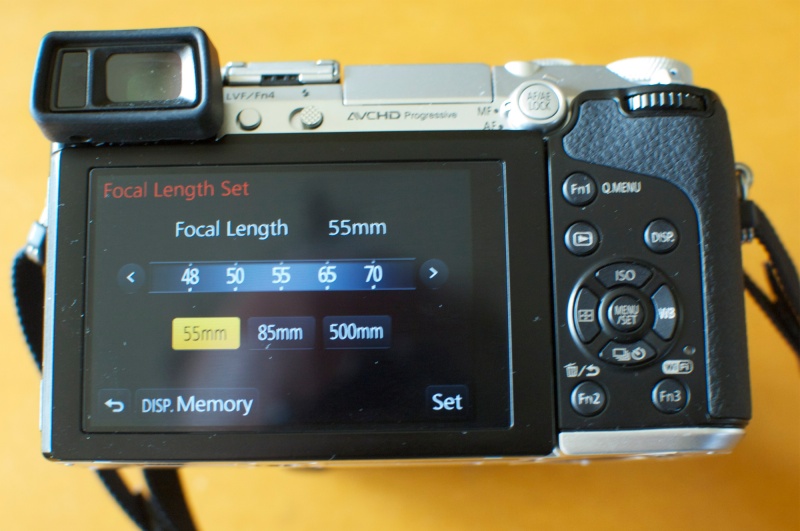
Adapter: I use this $14 adapter for my Nikkors. It measures to better than 1/10,000th inch parallelism between the front and rear flanges, at which point my micrometer gives out, so it will be good enough for the most fastidious. There is absolutely no play on the GX7 on either the body or lens flange. Recommended. The adapter comes in a host of lens mount fittings. At the price asked, you can spring for one for each of your favorite MF lenses.
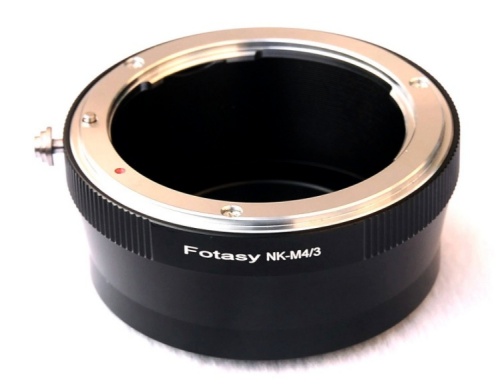
As I explained in my G3 review, few MF lenses actually make sense on the MFT body. You lose the automation and small size of MFT optics and have to add manual steps to make things work. But four of my Nikkors make eminent sense for use on the GX7:
55mm f/3.5 Micro Nikkor:
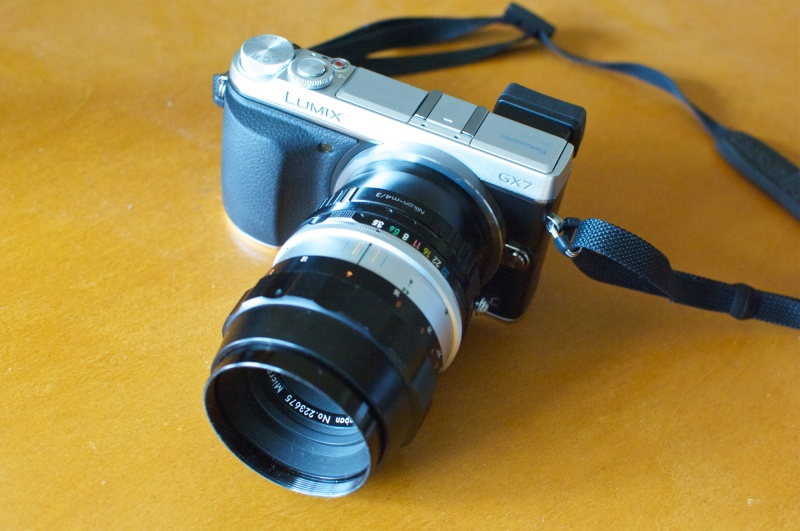
This outstanding (and very inexpensive) macro lens goes to half life-size on an FF body. It can be easily found for well under $100. On an MFT body it becomes an effective 100mm, doubling your subject distance for easier lighting, and now going down to life-life size without the need for any further adapters. MF is fine for contemplative macro use, making this a perfect companion to the GX7 body. Used on a tripod, the swiveling eyepiece and the LCD display make for ease of focus and composition. A perfect macro rig.
Here is the Micro Nikkor at closest focus – this is my D2x – at full aperture:
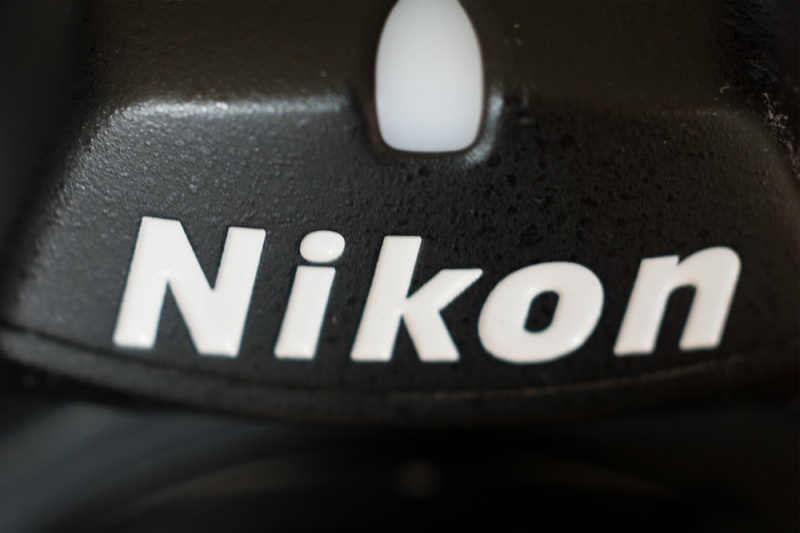
85mm f/1.8 Nikkor:
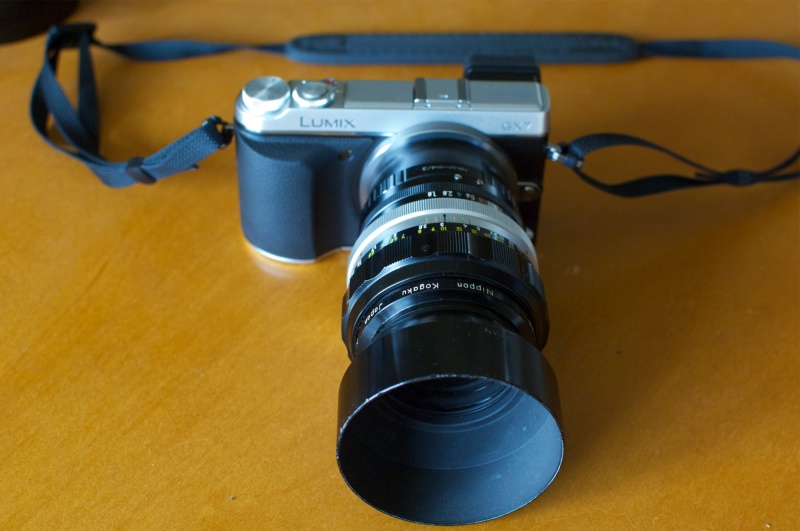
This one needs little explanation. Imagine using a 170mm f/1.8 at full aperture with the bulk of an 85mm lens ….

180mm f/2.8 ED IF AF D Nikkor:
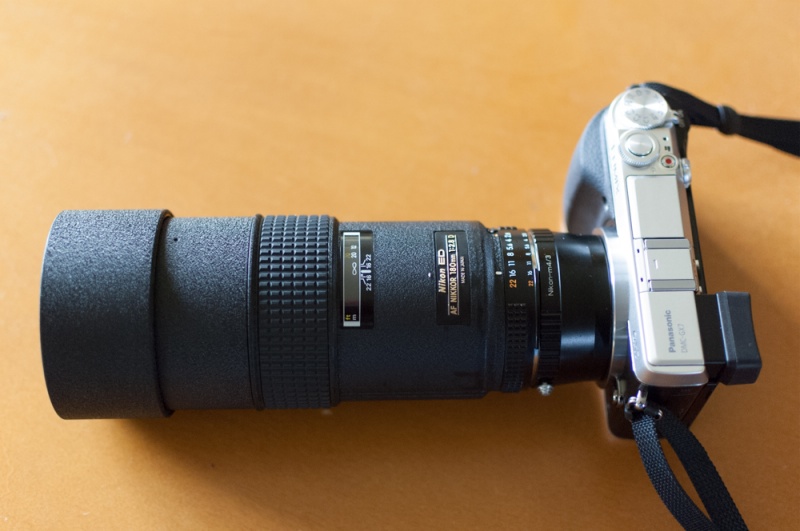
This is actually an AF D autofocus Nikkor which is easily switched to MF. D lenses have aperture rings, discontinued in the later, and current, G range. There’s one reason to use this optic and that’s to enjoy f/2.8 at an effective focal length of 360mm, where it is simply stellar. With the current 400mm AF f/2.8 Nikkor retailing at $9,000, you can do the math. The IF focus is light and precise and focus peaking really works well with this lens, for some reason. Other than that the 45-200mm MFT Panasonic zoom, which is f/5.6 at the long end, is easier to use.

500mm f/8 Mirror Reflex Nikkor:
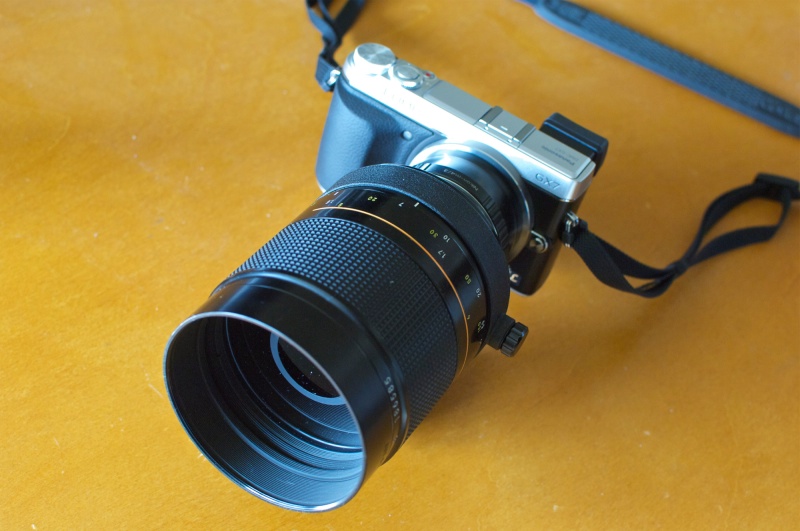
This lens is a natural for the GX7. The finder is bright, despite the slow, fixed f/8 aperture and IBIS adds what the G1/G3 sorely lacked. The outfit is very compact but you should seek out a support at all times, where possible. While there is no slapping nirror to hurt definition, the effective focal length is 1,000mm which is non-trivial to hand hold steadily, with depth of field being paper-thin. This dictates the use of the magnified central focus aid in the GX7 whenever possible. The exceptionally smooth operation of the focus collar in the Mirror Nikkor simplifies things considerably. The 1,000mm (effective) focal length is a nice step up from the 400mm (effective) limit on the Panny 45-200mm MFT optic.

Effectiveness of the in-body stabilizer:
Testing with and without the stabilizer switched on I estimate that the in-body stabilizer in the GX7 is worth 2-3 shutter speeds’ improvement over a non-stabilized lens. It works as well with AF MFT lenses from Olympus (which have no in lens stabilization – I own the 9-18mm Oly) as it does with MF Nikkors.
Conclusion:
Manual focus lens use on the GX7 will never be as easy as with an Olympus or Panasonic dedicated autofocus MFT lens, but it makes sense for a few select optics. The required adapters for old Manual Focus lenses are very inexpensive and of excellent quality.
In Part V I’ll take a look at a new technology in the GX7, absent from the G1/G3 – Wifi.
In the field.
Part II is here.
The desire for invisibility:
The primary task of any street snapping camera (and snapper!) is to become invisible. Literally, the equipment must be an extension of the user’s brain and eye. Historically this rôle was best filled by the Leica M rangefinder with a 35mm lens. Today, that specialty is best filled by small digital cameras fitted with a wide-to-modest-telephoto zoom lens, spanning the classic range afforded by a Leica with wide, standard and 90mm lenses. For the GX7 the optic of choice for the street snapper which best suits the task is the 14-45mm kit lens, equivalent to 28-90mm on full frame. It’s sharp at all apertures, focuses very fast and is silent. The Panny 20mm fails miserably on the last two tasks and is not recommended for street snaps. A modern MFT digital camera with a decent lens will easily deliver far larger and far better printed images than any film era Leica, and with far faster operational utility.
The first ‘roll’:
I snapped some 260 images (7 rolls!) on and around Mission Street in San Francisco the other day and the best news is that there’s little to report, other than that I really liked some of the results. I used Aperture Priority exposure and the RAW file format, as usual. The GX7 mostly nails exposure even in some of the very high contrast lighting scenes encountered. The body handles well and makes for a nicely balance rig with both the 14-45mm kit and 45-200 telephoto zoom Panasonic MFT lenses, both highly recommended. These are not fast optics but the GX7 renders images well even at ISO 1600 (where a touch of noise reduction in LR5 removes grain in really large prints). When a blurred background is called for a quick round-trip through Photoshop and use of the Magic Lasso and the Lens Blur filter does the trick. Color rendering is identical to that in the G1 and G3, which is to say it’s neutral. I used stock settings in the camera with no image filters or like nonsense.
The shutter:
I used the electronic shutter exclusively and the only person who will ever hear the muted susurrous it emits will be the person pressing the button, and that only in a very quiet room. To all intents and purposes the camera is silent, unless you use the ghastly Panasonic 20mm f/1.7 MFT lens with its grinding, bog slow, focus motor which will guarantee your street snaps are out of focus. The GX7’s shutter release features a nice two stage action, the first pressure focusing the lens, the second releasing the shutter and most of the time you will only know the shutter has been released when you see the quick blink in the EVF. For razor sharp responsiveness you can program the camera to take the picture after the first stage of release button pressure, at the risk of being out of focus. Would Cartier-Bresson have killed for this or what? I wrote about how fast, small digital cameras would take over for street snappers over six years ago and except that they have yet to become disposably cheap, that piece was bang on target.
The finder:
There is a slight delay when the camera is raised to the eye before the eye sensor switches on the EVF. In practice this can be mitigated by the simple expedient of lightly touching the shutter release as the camera is being raised to the eye.
The EVF works well, noticeably sharper than in the G1/G3 owing to all those added pixels, and while highlights in the EVF tend to get easily blown out, the effect is less so than in the earlier cameras. EVFs are making rapid progress and I doubt we will see any new cameras coming out with flapping mirrors a decade hence. Couple an EVF with an electronic shutter and you can pretty much have any framing rate desired, untroubled by the mechanical limitations of a flapping mirror and a mechanical shutter.
I did not use the LCD. That’s not a serious image making tool for what I do. The camera itself is unobtrusive, the boxy form factor making it look like any other point-and-shoot, immediately qualifying the user as a tyro. This is a good thing.
The snaps:

Legs and birds. At the CJM.
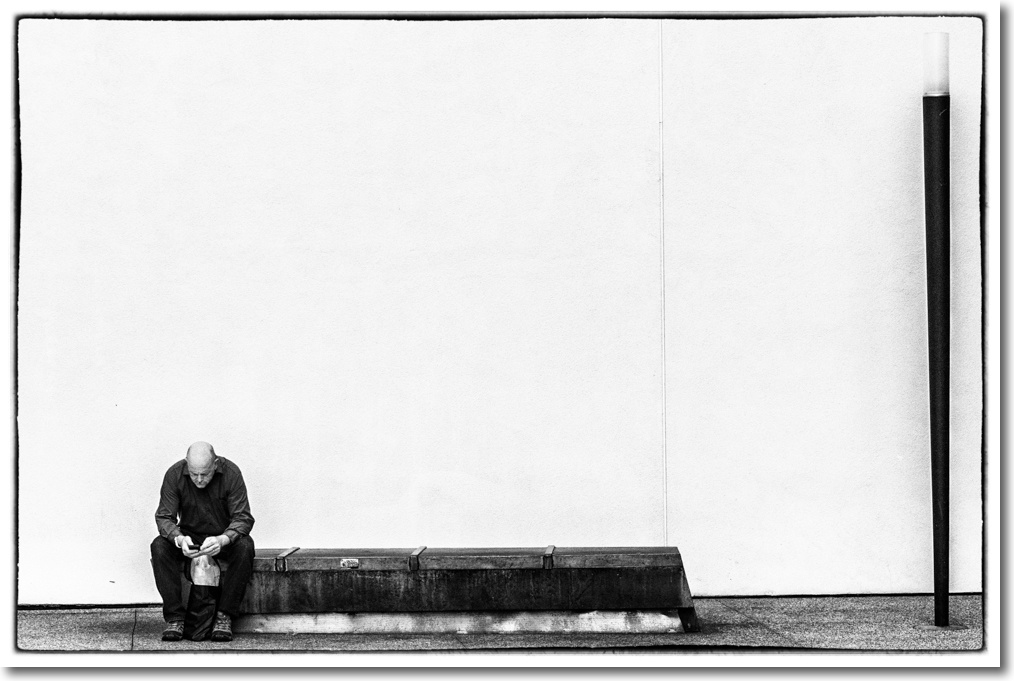
Alone. At the CJM.
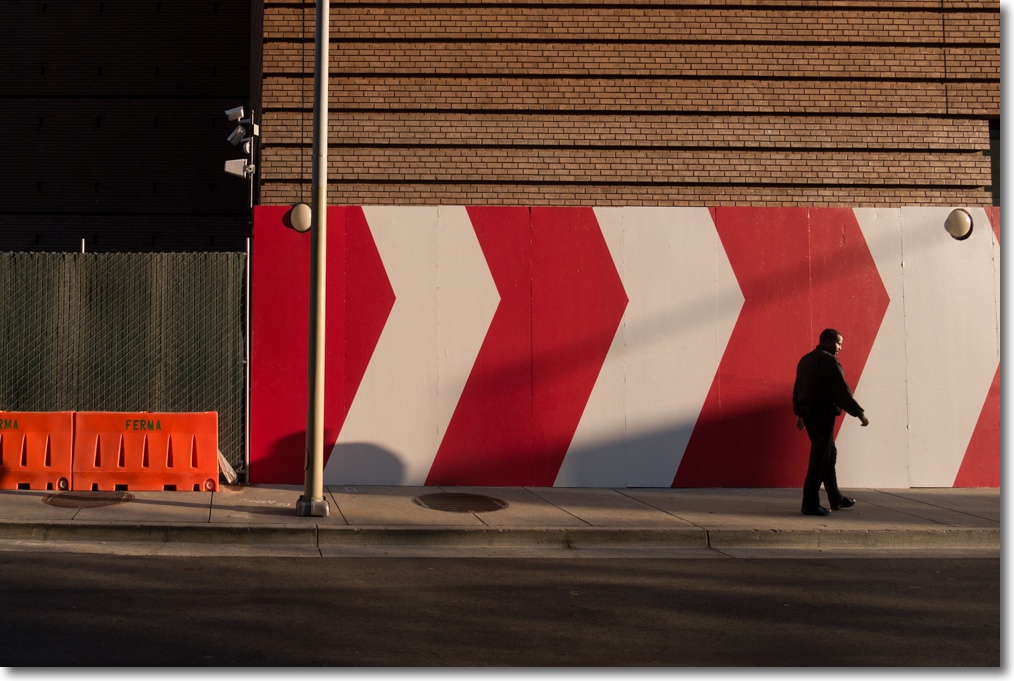
Chevrons. MoMA at Minna Street.

Heavy date. Yerba Buena gardens.
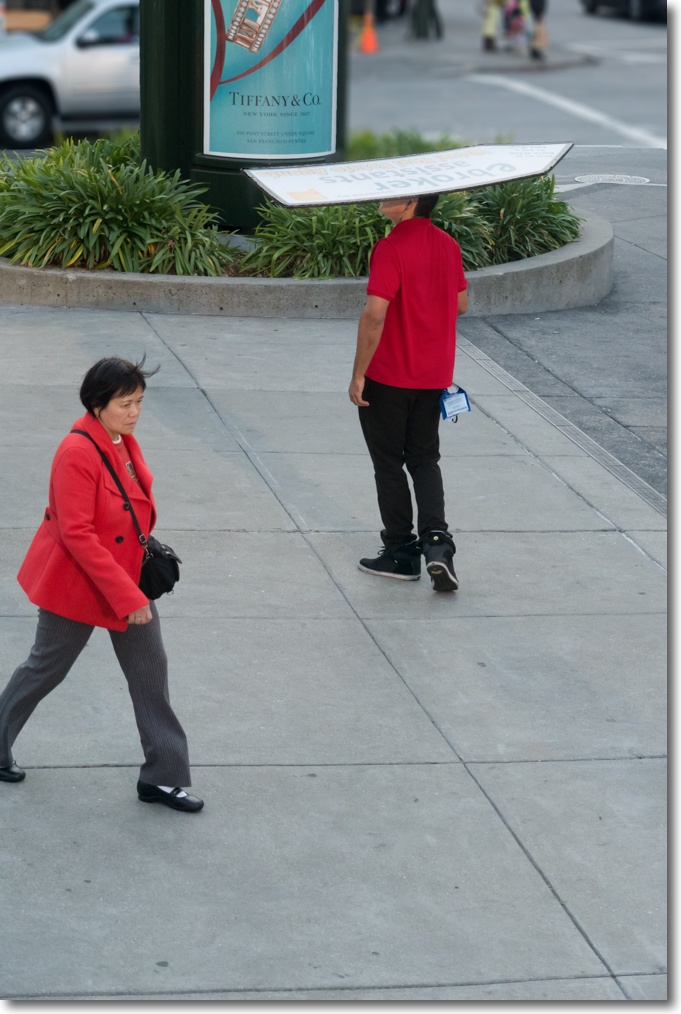
Head bored. At the Mission Street Convention Center.
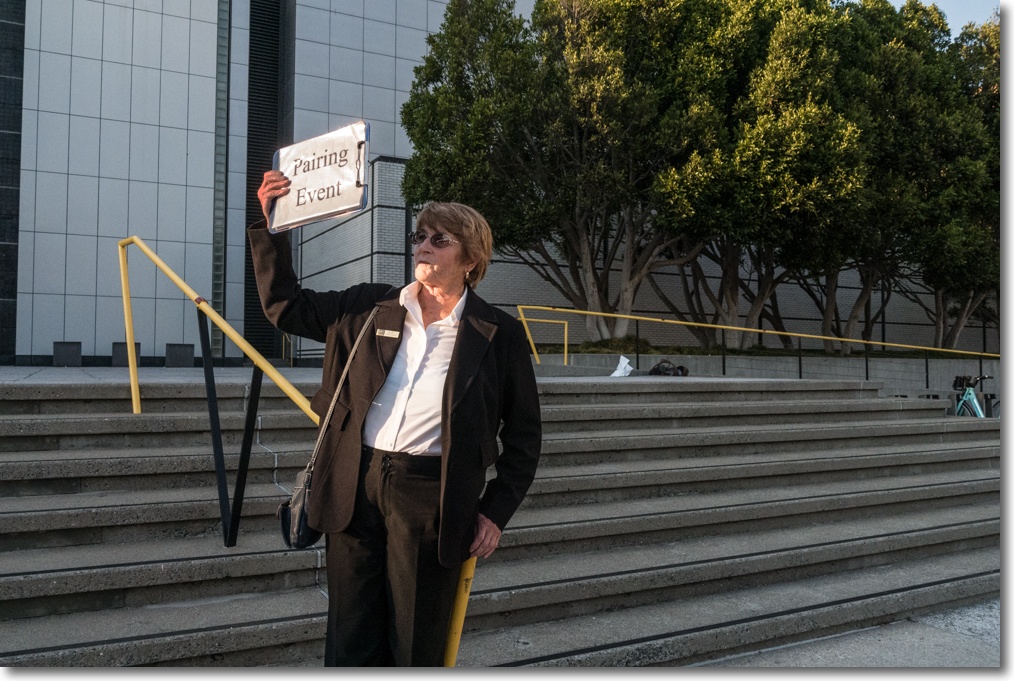
Pairing event. At the Mission Street Convention Center.
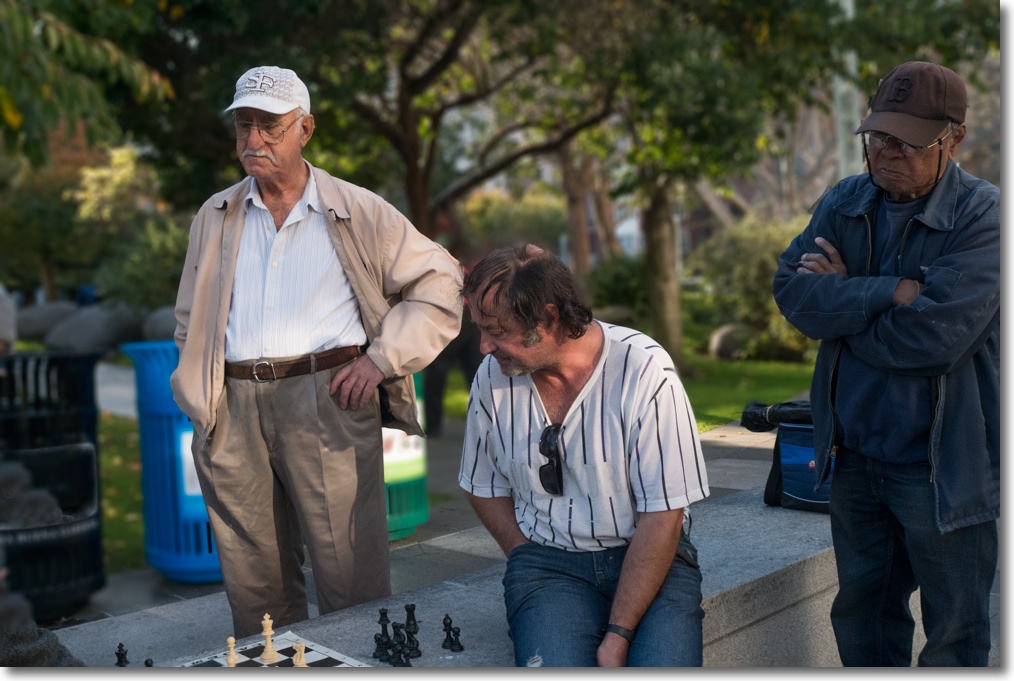
Chess. Yerba Buena gardens.

Waiting. Through the window from inside the Wise Brothers Jewish deli.
I had a pastrami on rye with kosher pickles, natch.
All snapped using the 14-45mm kit lens except the last which was with the 45-200 at full extension. ISO 400-3200 was used – the 6400 limit is unavailable in electronic shutter mode for some reason. By programming the three custom functions on the top right hand mode dial to 400, 1600 and 3200 ISO I could easily switch sensitivity with a click of the knob. The default setting is for the EVF (and LCD, if used) to show a 5 second still of the image after the picture is taken. This is intensely irritating for street snaps when you want to see what’s happening in the finder at all times, and I set the saved custom settings to no image view.
Processing:
RAW images were processed in Lightroom 5.2 with some round-tripped to PS CS5 when background blur was called for. The first two snaps above were round-tripped through Snapseed. At the time of writing, the latest version of iPhoto does not yet recognize GX7 RAW files nor does Apple’s Aperture. I have long questioned Apple’s commitment to still photography apps and this slow update cycle for their key applications seems to confirm my concerns. Aperture in particular, used by many pros, has a history of slow updates, whereas Adobe does an excellent, speedy job with Lightroom and with Adobe Camera RAW for Photoshop.
‘Rolling shutter’ nonsense:
You will see references in the geek press to the ‘rolling shutter’ effect which may be encountered with moving objects when using the electronic shutter in the GX7. For that matter you can get the effect with any mechanical focal plane slit shutter too. It results from the movement of the subject during exposure while the electronics scan (or the slit in the mechanical shutter passes over) the sensor and record the image. It’s an effect which is most famously visible in Jacques-Henri Lartigue’s fabulous race car image snapped in 1913 with a slow-moving focal plane shutter and a rapidly moving car. In street snapping the effect is irrelevant and not noticeable, though Lartigue, it must be said, made the best of it.
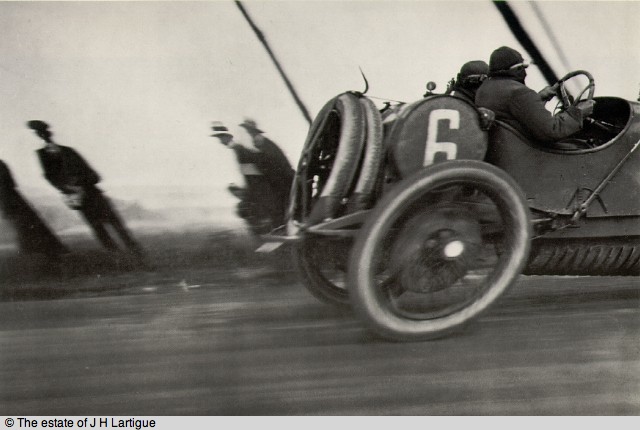
The cull:
I mostly used the maximum aperture available, occasionally stopping down one stop. Of the 260 images, 78 were ‘keepers’. The cull focused on poor composition, lack of drama and so on. In all cases I was to blame, not the GX7. Can’t complain about that or about the 30% retention rate.
Sensor dust in Panny MFT bodies:
As for sensor dust, I have never had as much as one mote with any of the G1 (14,000 images), G3 (5,000 images) or GX7 (260 images), despite changing lenses outdoors with abandon and no precautions taken. Nikon could do worse than learn Panny’s secret here for in my D700, D2x and D3x sensor dirt is very much the order of the day, even in my (sold) D700 which allegedly had a sensor cleaner built-in, though I can’t say I ever noticed the difference.
Ability to tailor the controls and functions:
This has jumped significantly from the G1/G3. There is so much ability to tailor the controls and operation of the GX7 to your liking that I cannot recall ever having encountered something so well thought out. Even my ‘pro’ Nikons are left in the dust in this regard. It makes for a bit more of a learning curve, but a lot of this tailoring is a one-off effort, whereafter the body is set just as you like it. The provision of a large number of programmable function buttons, both hardware and touchscreen, is especially welcome. Commendable.
Recommendation:
The GX7 is unreservedly recommended for the street snapper. Sports and birds-in-flight aficionados will have to look elsewhere for advice as I am clueless about both genres.
It is not cheap, the $900 for the body which I paid having now jumped to $1,000. Panasonic (and Olympus) body pricing seems focused on not being competitive with APS-C bodies, which is a shame as those manufacturers – especially Nikon and Canon – have not made any meaningful technological progress in years, sticking to noisy flapping mirrors and bulky glass pentaprisms. The new Sony FF bodies (A7 and A7R) with EVFs look technically promising, if butt ugly, and it will be a cold day in hell before Sony gets meaningful market share with these. The world is crying out for FF EVF bodies from Canon and Nikon, both of whom seem quite deaf to the demand.
A spare battery for the GX7 is de rigeur, just as soon as Panny makes them available.
If you can lay your hands on a 14-45mm Panasonic kit lens, in preference to the later 14-42mm which is not as good by many accounts, so much the better. Autofocus speed with this lens is instantaneous and the electronics never hunt. That body/lens combination will take you around the world and you will want seldom for other lenses. That’s very much in keeping with the MFT ethos – small and simple. Yes, the zoom collar could be smoother but that’s the only complaint I have. (Well, OK, the provided hood is huge and silly, but you can chuck it out). I recommend you avoid the alternative motor-operated power zoom lenses offered by Panasonic. A manual twist ring room is far faster in every respect, easier to use and drains no precious battery power.
In Part IV I’ll take a look at use with manual focus lenses, an area in which Panny’s design and engineering really excel.